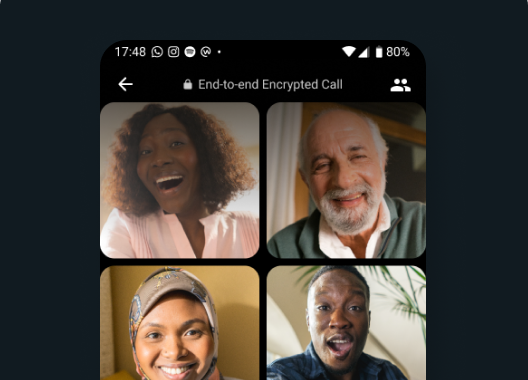In a significant stride towards enhancing its video calling capabilities, WhatsApp has rolled out several new features, making it a formidable competitor to established video conferencing platforms like Zoom, Google Meet, and FaceTime. The Meta-owned messaging app, widely known for its seamless text and voice messaging services, is now poised to become a preferred choice for video communication as well.

Expanded Participant Limit
One of the standout features of the latest update is the increased participant limit. Previously, WhatsApp allowed up to 32 participants in a video call only on mobile devices, while desktop users on Windows and macOS were limited to 16 and 8 participants, respectively. With the new update, WhatsApp now supports up to 32 participants across all devices. This enhancement aligns WhatsApp with Apple’s FaceTime, which also allows 32 participants, though still trailing behind Google Meet and Zoom, which can accommodate up to 100 participants on their basic tiers.
Enhanced Screen Sharing with Audio
Screen sharing, a feature that was introduced in August last year, has received a notable upgrade. Users can now share audio alongside their screen, making it possible to watch videos or share presentations with sound during a WhatsApp call. This improvement is particularly useful for collaborative tasks, virtual watch parties, and remote learning, bringing WhatsApp on par with professional conferencing tools that offer similar functionality.
Speaker Spotlight
Another significant addition is the speaker spotlight feature. During a video call, the app will automatically highlight the person who is speaking, bringing them to the forefront of the screen. This feature enhances the clarity of communication, especially in larger groups, by reducing the confusion about who is talking at any given moment. The speaker spotlight function is expected to streamline discussions and make group interactions more effective.
Introduction of Meta Low Bitrate (MLow) Codec
To further bolster its video calling experience, Meta has introduced a new codec called Meta Low Bitrate (MLow). This codec is designed to improve call reliability, particularly for users with poor network connectivity or older devices. MLow provides twice the audio quality compared to the previously used Opus codec while reducing computational complexity by 10%. This means clearer, more stable audio during calls, even in less-than-ideal conditions. MLow is already in use on other Meta platforms such as Instagram and Messenger and is now being integrated into WhatsApp to ensure a consistent calling experience across all Meta services.
Also Read: 5 Surprising iOS 18 Features That Android Had First
Broader Implications for Video Communication
These updates collectively enhance the usability of WhatsApp for both personal and professional communication. The ability to accommodate larger groups, share screens with audio, and highlight active speakers positions WhatsApp as a versatile tool for a wide range of applications—from virtual family gatherings to business meetings and online education.
By integrating these advanced features, WhatsApp is not only catching up with but in some aspects surpassing, its competitors. The convenience of having a single app for text, voice, and now highly capable video calls reduces the need for users to switch between different platforms for different types of communication.
User Reactions and Industry Impact
The user response to these updates has been overwhelmingly positive. Many users appreciate the enhanced functionality, especially those who prefer the simplicity and familiarity of WhatsApp over other, more complex video conferencing tools. The ability to host larger meetings and share audio during screen sharing has been particularly well-received among professionals and educators.
Industry experts view these updates as a strategic move by Meta to consolidate its position in the crowded video conferencing market. By leveraging the massive user base of WhatsApp, Meta aims to offer a comprehensive communication solution that can meet the needs of both casual users and professionals.
Future Prospects
Looking ahead, WhatsApp’s continuous improvements suggest that Meta is committed to evolving the app into a robust, all-in-one communication platform. With the integration of these new features, WhatsApp is likely to attract more users who might otherwise rely on multiple apps for their communication needs.
In conclusion, WhatsApp’s latest updates mark a significant enhancement in its video calling capabilities. The introduction of features such as increased participant limits, audio-integrated screen sharing, speaker spotlight, and the MLow codec sets a new standard for the app, making it a strong contender in the video conferencing arena. As WhatsApp continues to innovate, it is well on its way to becoming an indispensable tool for communication in both personal and professional contexts.
1 thought on “WhatsApp’s 5 New Features Make Zoom and Google Meet Unnecessary”